G.S. Rajendram1, S.F. Ledgard1, R. Monaghan2, J.W. Penno3, M.S. Sprosen1 and
L. Ouyang1
1AgResearch, Ruakura Research Centre, Private Bag 3123, Hamilton
2AgResearch, Invermay, PO Box 50034, Mosgiel
3Dairying Research Corporation, Private Bag 3123, Hamilton
Abstract
Losses of Ca, Mg, K, Na, nitrate-N, sulphate-S, Cl and inorganic P were determined in intensively grazed dairy pastures at three sites receiving no nitrogen fertiliser. The range of losses for each nutrient in kg/ha/year were 69-144, 10-46, 6-16, 32-79, 21-26, 39-89, 63-123 and <1 respectively. Measurements of leaching losses relative to nutrient inputs in fertiliser, rainfall and drench at DRC Number 2 dairy indicated that leaching of Mg exceeded inputs by approximately 20 kg/ha/year.
Leaching losses of the above cations and anions were also measured in dairy cow farmlets at DRC Number 2 dairy which received 0, 200 or 400 kg N/ha/year. The amount of nitrate-N leaching increased with increasing rate of N fertiliser application. This was associated with an increase in leaching of Ca of up to 100%. There was no significant effect on leaching of other cations.
Introduction
In New Zealand, there have been few studies on the leaching of anions and cations in intensive dairy farming systems. Charge balance needs to be preserved in leaching solutions and therefore a cation will accompany any anion leached. The leaching of anions and cations will be dependent on a number of factors including the amounts and form of nutrients applied in fertiliser, stocking rate, drainage, soil type and extent of previous leaching (McLaren and Cameron, 1990; Scholefield et al., 1993).
With the increasing use of N fertiliser on dairy farms over the past 5-10 years, there has been increasing concern about the impact on nitrate leaching to groundwater. Ledgard et al.(1996) showed that increased N fertiliser application on dairy pasture resulted in increased nitrate-N concentrations in groundwater. Leaching of nitrate also results in leaching of associated cations and this has implications to the requirements for nutrients in the farm maintenance fertiliser programme and to the lime requirement (Sinclair et al., 1993).
The aim of this study was to determine the amounts of Ca, Mg, Na, K, nitrate-N, sulphate-S, Cl and inorganic P leached from intensively grazed dairy pasture at 3 sites in the absence of N. In addition, nutrient leaching was determined in dairy farmlets at one site receiving 0, 200 or 400 kg N/ha/year.
Method
Farmlets receiving no nitrogen fertiliser
1. Waikato farmle
Cation and anion losses were measured in 1995 in a farmlet at the Dairying Research Corporation (DRC) No. 5 dairy which received no N fertiliser. Soil solution at 1 metre depth was collected using 30 ceramic cup collectors at 2-3 weekly intervals ( Sprosen et al., 1997). Calcium, Mg, Na and K were analysed using atomic absorption spectroscopy, nitrate-N using flow injection autoanalyser, sulphate-S using high pressure ion chromatography, and chloride using uv/vis spectroscopy. The farmlets were rotationally-grazed by dairy cows. The soil type was a moderately-well drained Bruntwood silt loam (Aquic Hapludand) derived from volcanic ash.
Drainage was estimated from the volume of water passing through lysimeters (0.4 m diameter by 1 m depth) containing intact soil cores. Data for drainage and nutrient concentrations were used to calculate the amount of nutrients leached.
2. Southland farmlet
Leachate from mole and tile drains was collected at frequent intervals from 6 non-N-fertilised paddocks (Monaghan, unpublished) in 1996 and was analysed for anions and cations as described above. Inorganic P was analysed using uv/vis spectroscopy. The paddocks were rotationally grazed by cattle. The soil was a Fleming silt loam which is a naturally poorly-drained sedimentary soil.
DRC No. 2 dairy, Hamilton
Cation and anion losses were measured in 1995 and 1996 in a farmlet at the DRC No. 2 dairy near Hamilton which received no N fertiliser. Soil solution at 1 metre depth was collected using 30 ceramic cup collectors at 2-3 weekly intervals (Ledgard et al., 1996). The soil was a free-draining Silverdale silt loam (mottled orthic brown soil). Cations and anions in leachate were measured as above.
Farmlets receiving nitrogen fertiliser
DRC No. 2 dairy, Hamilton
Measurements were made of anion and cation leaching in farmlets at the DRC No. 2 dairy near Hamilton. Treatments received 0, 200 or 400 kg N/ha/year as urea in 8-10 split applications throughout the year (Table 1).
Table 1: Nitrogen fertiliser applied as urea to farmlets at DRC No. 2 dairy Hamilton (Penno et al., 1996).


Leachate from the free-draining Silverdale silt loam (mottled orthic brown soil) was collected using ceramic cup samplers located at 1 metre depth (30 samplers per treatment). Groundwater was also sampled using piezometers (3 per treatment; to a depth of 6 m) located within grazed paddocks of each treatment. The solutions were analysed as above for cations and anions. Phosphate in groundwater was also analysed. The extent of water drainage from each treatment was measured using lysimeters (0.4 m diameter by 1 m deep) containing undisturbed soil cores.
The nutrient inputs via fertiliser and rainfall (which were measured) are summarised in Table 2. Fertiliser inputs were muriate of potash applied at 100 kg/ha/year and superphosphate applied at 600 kg/ha/year. Lime was applied to the farmlets at commencement of the trial in 1993.
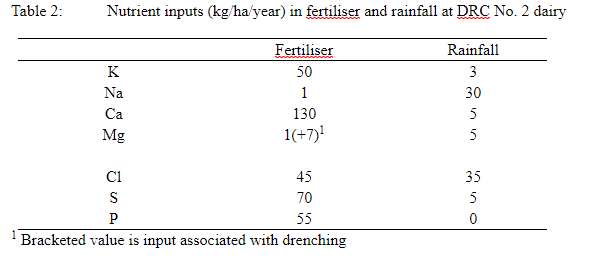
Results
Farmlets receiving no N fertiliser
High losses of calcium, magnesium, sodium, nitrate-N, sulphate-S, and chloride were observed for the farmlets at No. 2 dairy Hamilton, Waikato and Southland (Table 3). There were lower losses of potassium and inorganic P (all < 1 kg Pi/ha). At each site, the annual amounts leached from the grazed pasture receiving no N fertiliser were in the order Ca > Na > Mg > K and for the anions were in the order Cl > sulphate-S > nitrate-N. At No. 2 dairy, the amounts leached were higher in 1996 than 1995, which coincided with greater drainage.

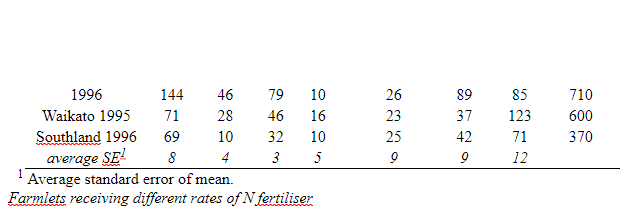
The amounts of calcium and nitrate-N leaching increased ( p< .001) with increasing rate of N fertiliser application at DRC No. 2 dairy during 1996 (Fig. 1). However, there was no effect of N application on leaching of the other cations. The range in amount of nutrients leached across all N farmlets (including 400 N high stocking rate) for Ca, Mg, Na, and K were 140-280, 45-50, 70-80 and 10-15 kg/ha/year, respectively. The corresponding results for leaching of nitrate-N, sulphate-S, and chloride anions were 25-125, 55-90, and 80-110 kg/ha/year, respectively. This year coincided with a high drainage (670-710 mm) and therefore losses were probably greater than normal.
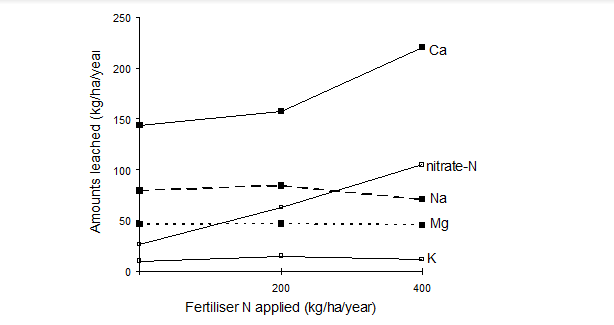
Fig.1: Amounts of nutrients leached with increasing rates of nitrogen fertiliser application at DRC No. 2 dairy, Hamilton in 1996. The SED for comparison between N treatments is Ca (29), Mg (8), Na (10), K (6) and nitrate-N (29).
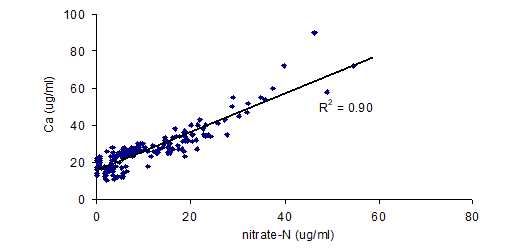
Fig. 2: Correlation between Ca and nitrate-N concentrations in leachate from individual samplers (1 m depth) collected at DRC No. 2 dairy, Hamilton.
There was a highly significant (p< 0.001) correlation between the concentrations of nitrate and calcium obtained from individual collectors at 1 m soil depth (Fig. 2).
Calcium and nitrate-N concentrations in groundwater at No. 2 dairy increased with increasing N inputs (Fig. 3). These treatment effects were similar to those found in the leachate at 1 m depth. Groundwater concentrations of Ca, Mg, Na, K, nitrate-N, sulphate-S, and chloride were 8-21, 4-18, 7-13, 2-5, 3-20, 4-9 and 10-30 ug/ml, respectively. These concentrations were of a similar magnitude to those in the leachate at 1 metre depth.
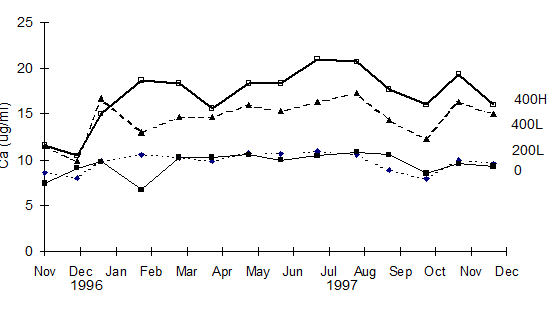
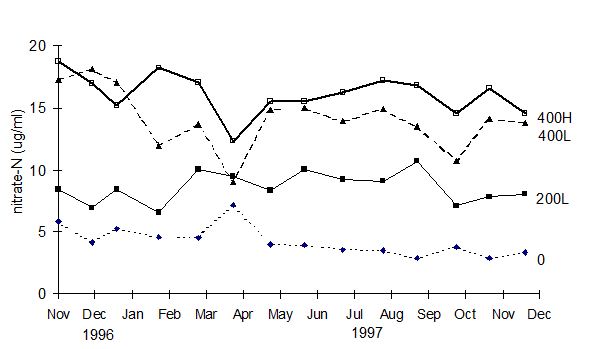
Fig. 3: Groundwater calcium and nitrate-N concentrations at DRC No. 2 dairy, Hamilton during 1996 and 1997. Average SEDs are 3.8 (range 2.3-5.2) and 4.6 (range 1.9-6.4) for Ca and nitrate-N, respectively.
Discussion
The amounts of cations and anions leached from the farmlets receiving no nitrogen fertiliser represented a significant removal of these nutrients from the system, particularly under high drainage. Leaching losses for cations and anions were similar between the different non-N-fertilised farmlets despite differences in soil drainage characteristics, region and management practices (Table 3). The losses via leaching with respect to amounts added via fertiliser and rainfall at No. 2 dairy, for the 1995 and 1996 years were K (15%), Na (200%), Ca (90%), Mg (260%), Cl (93%), sulphate-S (85%) and inorganic P (<2 %). Thus the amount of Mg and Na lost via leaching greatly exceeded the inputs in fertiliser, rainfall and drench. A summary of soil Mg tests on dairy farms in the Waikato between 1980 and 1990 (Roberts and Morton, 1998), indicated declining Mg levels over time. A significant factor in this decline may be attributed to the large leaching losses.
Leaching losses of Ca, Cl and sulphate were also significant (approximately 90%) relative to the total inputs in fertiliser and rainfall. In the 400N farmlets, the leaching loss of Ca doubled compared to that in the 0N farmlet and this resulted in losses exceeding total Ca inputs. This indicates that farmers using moderate-high rates of N fertiliser should be aware of Ca requirements and should avoid long-term use of fertilisers which do not contain Ca (eg. DAP).
In forest and extensive grassland, McLaren and Cameron (1990) noted that leaching of Ca was approximately 10 kg/ha/year. However, in the present systems under intensive cattle grazing in the absence of N fertiliser the amount of Ca leached was much higher at 69-144 kg/ha/year. Similarly, Steele et al. (1984) also measured high Ca leaching from cattle grazed pastures in Northland.
The major cation leached with nitrate was calcium and the high concentrations in some leachate collectors (at 1m depth) were attributed to spatial urine deposition ( Fig. 2). Urine patches receive the equivalent of approximately 1000 kg N/ha and significant leaching losses can occur from these (Haynes and Williams, 1993). The significant increase in the concentrations of calcium and nitrate-N in leachate and groundwater with increase rate of N application was attributed to the preference for Ca leaching with nitrate-N. Calcium dominated the cation exchange sites, and constituted 86% of the CEC in the soil at No. 2 dairy.
There was no effect of rate of N fertiliser application on leaching of the other cations and anions (Fig. 1).
Conclusions
This study indicated that high leaching losses of Ca, Mg, Na, nitrate-N, sulphate-S and Cl occurred from intensively grazed pasture and that increased farming intensity, through the use of N fertiliser, increased the losses of Ca and nitrate-N. This result has important implications to the sustainability of these systems, the potential for increase in incidence of hypocalcaemia and hypomagnesaemia in animals, and the requirements for nutrient inputs in fertilisers.
References
Haynes, R. J. and Williams, P. H. (1993). Nutrient cycling and soil fertility in the grazed pasture ecosystem. Advances in Agronomy 49, 119-199.
Ledgard, S. F., Selvarajah, N., Jenkinson, D., and Sprosen, M. S. (1996). Groundwater nitrate levels under grazed dairy pastures receiving different rates of nitrogen fertiliser. In: Recent developments in understanding chemical movement in soils: Significance in relation to water quality and efficiency of fertiliser use. (Eds L D Currie and P Loganathan). Occasional report No. 9. FLRC, Massey University, Palmerston North. pp. 229-236.
Ledgard, S. F., Sprosen, M. S., Brier, G. J., Nemaia, E. K. K. and Clark, D. A. (1996). Nitrogen inputs and losses from New Zealand dairy farmlets, as affected by nitrogen fertilizer application: year one. Plant and Soil 181, 65-69.
McLaren, R. G., and Cameron, K. C. (1990). Potassium, calcium, magnesium and sodium. Pp. 228-236. In Soil Science – An Introduction to the Properties and Management of New Zealand Soils. (Eds. R. G. McLaren and K. C. Cameron) Oxford University Press, New York.
Penno, J. W., MacDonald, K. A. and Bryant, A. M. (1996). The economics of No 2 dairy systems. Proceedings of the Ruakura Farmers’ Conference48, 11-19.
Roberts, A. H. C., and Morton, J. D. (1998). Hindsight and foresight: Current and predicted future trends in nutrient requirements for dairying. (This proceedings)
Scholefield, D., Tyson, K. C., Garwood, E. A., Armstrong, A. C., Hawkins, J. and Stone, A. C. (1993). Nitrate leaching from grazed grassland lysimeters: effects of fertilizer input, field drainage, age of sward and patterns of weather. Journal of Soil Science 44, 601-613.
Sinclair, A. G., Edmeades, D. C., and Ledgard, S. F. (1993). The influence of phosphorus, sulphur and nitrogen fertilisers on acidification in pastoral soils. Proceedings of the NZ Fertiliser Manufacturers’ Research Association Conference 22: 106-116
Sprosen, M. S., Ledgard, S. F., and Thom, E. R., (1997). Nitrate leaching is similar in N2-fixing clover-grass pasture and N-fertilised grass-only pasture at similar N inputs. Proceedings of the New Zealand Grassland Association 59 (in press).
Steele, K. W., Judd, M. J. and Shannon, P. W. (1984). Leaching of nitrate and other nutrients from a grazed pasture. New Zealand Journal of Agricultural Research 27, 5-11.
.